
A Cave of Candles / by Dorothy V. Corson

Chapter 24
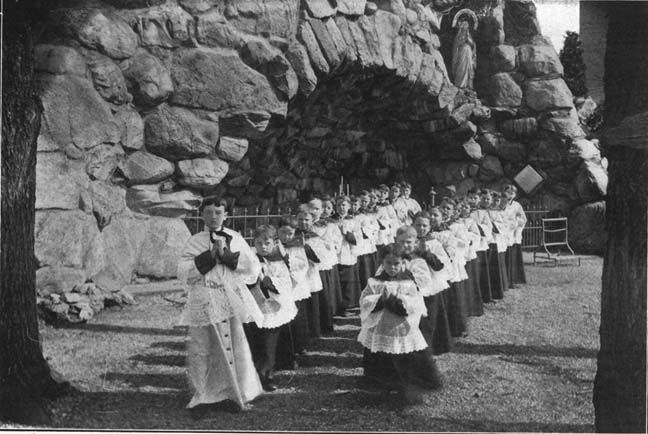
The Last Pieces in the Grotto Puzzle
Having fully explored every interesting and unexpected side path related to Our Lady and the Grotto, I now found myself nearing the end of my trail of memories. It was time to add the last remaining pieces to complete my Grotto puzzle. Among other things, I finally located confirming evidence of the last item about the 1896 Grotto mentioned in Father Maguire's letter. The "beautiful dell" description he disputed in his letter:
The spot chosen was not a 'beautiful dell' but an old midden where everything from old shoes and tin cans or what have you were thrown -- just a dump heap. When it was decided to build the Grotto there old Brother Phillip had his crew clean up the rubbish before the work was begun.
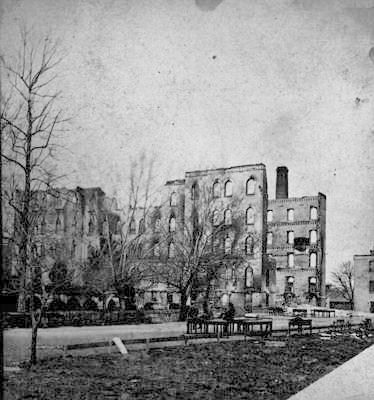
Finally, an item in the June 1879, Scholastic explains the origin of the rubbish:
The rubbish of the burned buildings after the fire was taken to fill the low ground west of the church and presbytery and the charcoal was put in barrels while the loose mortar was gathered and spread on the roads.
The much admired artificially trimmed cedar trees which were scorched on one side were bound to go. The familiar cut forms look lonely enough turned up side down with other rubbish near the lake."
A striking firsthand description of the atmosphere during the 1879 fire is recorded on the same page:
The force of contrast has been strikingly illustrated by two circumstances connected with the fire. One is the tall chimney of the steam-house, which seems so very tall since the college has disappeared from its front. Standing without relief among the little buildings that are left, it seems to have suddenly shot up into the blue sky. The other contrast to which we refer is the striking of the clock in the Church tower during the burning of the College. At twelve, at one, and at two the solemn strokes were sounded as usual, but with almost supernatural effect upon the ear, as if the clock of eternity were knelling the conflagration of the globe and the destruction of all things. Time marked its ceaseless course through the terrible burning, even as it had done in the hours of peace, study and prayer. We shall never forget that bell, unruffled and peaceful, as it was heard, and barely heard, amid the crackling and roaring of the flames, the falling of walls, the noise of the engine, the rushing and hissing of water and the loud shouts of men -- the peaceful but appalling sound of these sweet church bells striking the hours of God's ever passing time, His quiet, all-embracing Eternity. (289)
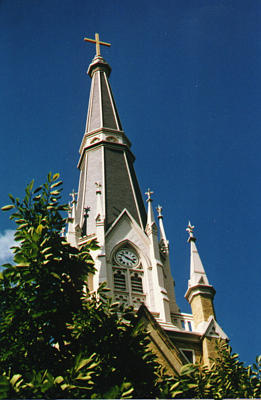
In the concept of "God's ever passing time," it is interesting to be reading and imaging those words 115 years later.
An 1896 Scholastic article entitled, "Where Peace Is," describes the area designated for the new Grotto and also mentions the debris from the fire:
This was Father Sorin's garden, created for him by the hands of his children in Christ. Once upon a time, . . . the ground sloped down from the west wall of the church to the water's edge, thirty yards distant; and after the garden was planned, it took many tons of earth to build the broad terrace. But it was all 'for Father General,' and the work grew apace. Rose bushes sprang up, and flowers of all sorts. Then came the great fire and the plot was suddenly widened. The lake was driven backward.
Seventeen years passed from the time the rubbish was first dumped there after fire. Much fill went on top of it as the grounds around Father Sorin's garden were landscaped and improved. Until in the spring of 1896:
The workmen came with picks and shovels, a month or two ago, to chop in the garden's lower edge a niche for the new grotto of Lourdes . . .(290)
Another source indicates the "beautiful dell" reference stems from even earlier days, before the fire and Sorin's 1878 shrine-like Grotto. During those times pilgrimages were made to the numerous shrines in the area of the Portiuncula chapel with the last stop being the Sacred Heart Church:
Just behind the presbytery is a little wooded dell which has always been regarded as one of the charming spots of Notre Dame. For years past the pilgrims from Kalamazoo and Jackson have chosen it as a resting place after their long journey; it has been a favorite walk with visitors at all times; and during the spring and autumn those who live at Notre Dame seek it instinctively for its coolness and attractiveness. It is where the [new] Grotto has been built.(291)
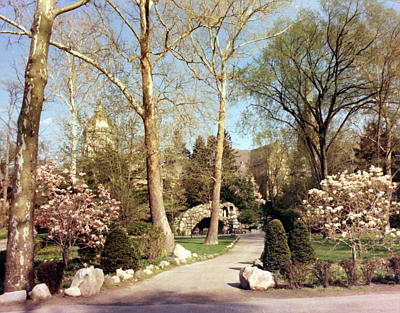
Father Maguire was right on target about the rubbish though he did not know its origin or that it had been buried for seventeen years until the construction of the new Grotto. With this key information, it was evident where all those curious items had come from. Probably everything imaginable was dumped behind the presbytery in what became the "wooded dell" area after the fire. Then dirt fill was piled on top of that and the wooded area was re-landscaped. When the cave was carved out of the slope of this refurbished area to build the present Grotto, the debris was unearthed. It is interesting to note that the Grotto at Lourdes in France was also a dumping place and repository for all manner of refuse.
One day, while exploring the Grotto area, I found what may be more evidence of the fire debris. I chanced upon what appeared to be a hunk of marble, like a rock outcropping, nestled among the trees along the roadway on the left side of the path north of the Grotto. The only words visible above the ground were, thday Gift. I wondered if it was a piece of discarded statuary, possibly a birthday gift to Father Sorin, that was broken when it was thrown out a window during the fire. Being apart from the main cavern of the Grotto, might explain why it had been left undisturbed for more than a century. Another rough hunk of white marble, on the left side of the Grotto path leading to the Church, has a curious symbol carved on it -- two more mysterious items with stories to tell that may never be known.
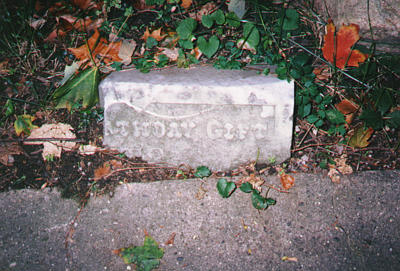
Before he died, my 99 year old friend, Brother Vitus, told me about a huge piece of soapstone on the right side of the Grotto near the top of the steps leading to the church. He said there is a mountain of soapstone like it out west. My dictionary describes it as a stone that feels somewhat like soap and is used for griddles and hearths. As yet, I have not been able to discern which one it is. It must have been quite a feat for the stonemasons to position such huge boulders without mechanized equipment.
The names of two more masons said to be among those who helped accomplish this 19th century work of art came to my attention just in time to be included in this narrative -- Boleslaus Luzny and Victor Callicrate. Both men were listed as working masons in the 1896 city directory and both families were connected with the Notre Dame campus. I received my first information about Boleslaus Luzny from Bernard Pinkowski, a local South Bend writer, and a friend of Boleslaus Luzny's daughter Clara. She worked in Notre Dame's Main Building most of her adult life and was also godmother to his child. He told me that many times she sat at their dinner table and told of how her father helped build the Grotto. She spoke of the huge supporting stone at the base of the Grotto which her father always pointed out to her as one he had positioned there. Father Francis Luzny, a Holy Cross priest, now deceased, was also related to this family and I'm told repeated the same story.
Another bit of Luzny information was provided by another Grotto interested person, who was given my name to contact by the Indiana Province Archives Center. Leonard Preuss, another descendent of the Luzny family, was looking for evidence to confirm a family story he had heard, that his great uncles had worked on the Notre Dame Grotto. He sent me their obituaries and included the interesting South Bend Tribune article on the art of stonemasonry which was quoted in an earlier chapter about Copshaholm. These two sources confirmed the family story told to Bernard Pinkowski by Clara Luzny, daughter of Boleslaus Luzny:
The Luzny brothers were brought to South Bend from Germany (Polish Province) by the Oliver family to work on the Oliver home . . . Frank Luzny, his brother Boleslaus, and his cousin Roman worked on the Studebaker and Oliver mansions. They had their trade from the old country.(292)
Boleslaus Luzny and Frank Luzny were brothers who came to South Bend from Europe in 1881. Being among the first masons in South Bend, both were organizers and charter members of Bricklayers' & Mason's Local No. 18. Boleslaus' obituary indicates:
His first job when he arrived here from Poland was at the University of Notre Dame where he was hired by Rev. Edward Sorin, C.S.C., founder of Notre Dame.(293)
Several days after receiving this information, I was informed by the University Archives that a couple from Colorado had been in that morning inquiring about the Grotto. The woman's family name was Callicrate and she had been told that her grandfather, father and an uncle had worked on the Grotto. She was hoping to find information about them in the archives. Again, the only evidence the archives could supply was the fact that he was listed as a mason in the 1896 city directory. They were flying home to Colorado that afternoon and were given my name to contact.
When I called her in Colorado, she was able to give me the name of a 92 year grandson of Victor Callicrate living in South Bend. He said he was also told that his grandfather Victor Callicrate, and two of his sons worked on the Grotto. The Callicrate name is also associated with Notre Dame. One of Calligrate's sons, Dominic, was captain of the 1907 football team.
He then added another bit of campus lore that was new to me. He said in his day the community cemetery for the religious was called, "Boot Hill."
Curious, I checked my dictionary for its true meaning. I found this interesting, and very apt, definition: "a cemetery in or near a frontier town of the old West." And the meaning of frontier? "The farthest part of a settled country, where the wilds begin." In Sorin's time it definitely applied, being on a hill, in the town of Notre Dame, Indiana. This region was referred to in Sorin's time as the Old Northwest, a new frontier in those days.
The number of masons reported to have worked on the Grotto was growing. There was John Gill the contractor, Charles McCoy, Nick and Lod Kowalski, Boleslaus Luzny, and possibly his brother Frank, Victor Callicrate and his sons and Peter Kintz and his sons. Peter Kintz was the only one not listed as a working mason. It was he who reportedly paid on the mortgage on his land, which was held by Father Walsh at Notre Dame, by helping build the Grotto. The sons may have worked along with their fathers as laborers. Man power would have been needed, masons as well as laborers. It was not an unusual number of men for that big and heavy a project. Customarily, one laborer works with two masons but in this case the huge boulders might have required extra hands and horses which might have been supplied by farmers, like Kintz and his sons, upon delivering their stone. John Gill and his mason, Charles McCoy were the only ones noted in the Grotto expense ledgers. As the contractor, Gill probably hired extra men and paid them himself which would account for the additional mason's names not being in the expense ledgers.
This final note from the Provincial Archives Center records reveals that as Father Maguire mentioned in his letter, Father Carroll paid not part of the Grotto costs but all of it, about $2,500, and left this proviso in his last letter regarding the Grotto:
. . . provided you on your part, carry out all that you promise. As you say, I may end my days at Notre Dame under the shadow of the grotto. Favor I wish inscribed on the marble slab, that the blessed Mary, Our Lady of Lourdes may obtain for me the Grace of a happy death.(294)
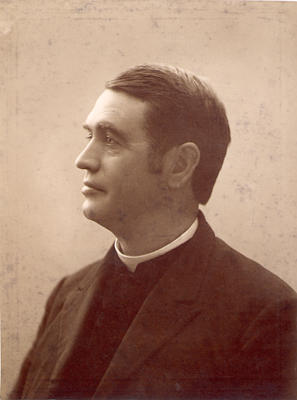
Though the Carroll plaque is weathered and worn those words are still discernible on the donor plaque. Following is an 1896 entry in the Scholastic about Father Carroll's beneficence:
Rev. Thomas Carroll of Oil City, Pa., was a student here in 1855. He was ordained in 1859. His name, to those at Notre Dame who have never met him, has come before him, for it is inseparably linked with the history of our beautiful 'Grotto of Lourdes,' which his beneficence made possible.
Father Carroll has been an indefatigable builder. To him is due the honor of erecting one of the 1st Catholic churches and presbyteries ever reared in South Bend -- old St. Patrick's. To this man's generosity Notre Dame owes one of her most beautiful, most faith-inspiring scenes, a shrine to which not only we at Notre Dame, but others from outside, carry burdens and go away relieved.(295)
More on the subject of his generosity appeared in the Scholastic upon his death:
Out of the wealth that his business like methods enabled him to acquire, he founded one of the first scholarships at Notre Dame. In doing this he built for himself another monument that time can not destroy. No one knew better than he the need the Catholic young man has for education and no one was more willing than he to help the good work along. The scholarship at Notre Dame is only one of many that he directed to be founded in this country, in Italy and in Ireland.
Only three years ago the back of the Community house was nothing but a bare brown mound with an old willow and one or two poplar trees . . . . 'Here in the quiet of the grove so close to the Church of the Sacred Heart was a location suitable in every respect' In a few months the Grotto was completed (1896). Father Corby selected the site. Corby to Carroll 'Let the Grotto be built here and let those that visit it say a prayer that God may grant us both a happy death.' The Grotto was built there and now three years later both are dead, within months of each other.(296)
Having gone as far as I could on this personal journey into the past, and having verified every item in Father Maguire's letter, I found myself being led full circle back to my original focus, establishing, once and for all, the origin and the originator of the present Notre Dame Grotto and how it came to be.
After so many divergent paths taken in my search for answers, it seems only fitting to conclude my story with the evidential excerpts I found, that fueled my desire to research and verify every record available associated with Our Lady and the Grotto -- built in 1896 and now fast approaching its 100 year centenary in 1996.